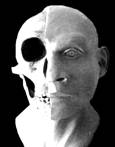 |
||||
|
775-842-7137 |
||||
|
|
||||
|
|
||||
|
|
||||
|
|
||||
|
|
||||
|
|
||||
|
|
||||
|
|
||||
|
|
|
All sculptures, drawings and images: ©2008, Penelope Siig/PSI Studios. All rights reserved. |
|
|
||||||||||||||||||||
|
The tissue depth method utilizes standard measurements of facial skin thickness, applied to the skull in the form of tissue depth markers, to guide the artist in the reconstruction of soft tissue and restoration of the face. Skin-depth charts have been developed from data collected over many years by scientists, physicians and anatomists. The expertise of a forensic anthropologist, who provides necessary data regarding the sex, age and derivation of the individual skull, is required in all forensic facial reconstructive work relative to the identification of missing persons or victims of crime or other tragic circumstances. References:
|
